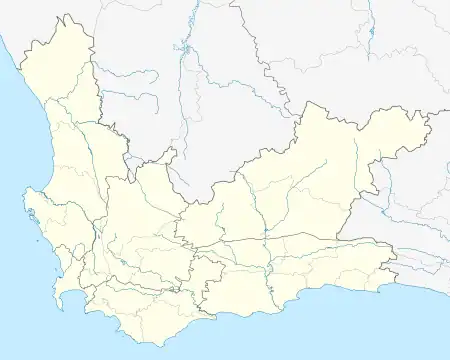Witsand
Witsand, Western Cape, South Africa, is a small coastal town, situated on the banks of the Breede River estuary. Witsand (Western Cape) is home to 4 kilometers of clean, sandy beaches, surrounded by a magnificent variety of Cape Fynbos species and the Breede River. The town is known as the Whale Nursery of South Africa due to the high concentration of whales in the bay between June and November. Witsand is an authentic water-sport and adventure destination with kite-surfing, surfing, standup paddle boarding and fishing as top visitor experiences. The town is located within the Hessequa region, which is branded as The Explorer's Garden Route .
Witsand | |
|---|---|
 Witsand  Witsand  Witsand | |
| Coordinates: 34.395°S 20.841°E | |
| Country | South Africa |
| Province | Western Cape |
| District | Garden Route |
| Municipality | Hessequa |
| Area | |
| • Total | 2.71 km2 (1.05 sq mi) |
| Population (2011)[1] | |
| • Total | 321 |
| • Density | 120/km2 (310/sq mi) |
| Racial makeup (2011) | |
| • Black African | 9.7% |
| • Coloured | 2.2% |
| • White | 87.2% |
| • Other | 0.9% |
| First languages (2011) | |
| • Afrikaans | 72.3% |
| • English | 26.0% |
| • Other | 1.6% |
| Time zone | UTC+2 (SAST) |
| PO box | 6666 |
| Area code | 028 |
The town from a tourism perspective, boasts a variety of accommodation options, eateries and a rum distillery. The Witsand Remote Locations Glamping is a unique getaway option, while the Witsand West Park Resort and Witsand Middle Park Resort ensures a bumper holiday season.
Witsand has seen some of the largest bull sharks caught in the Breede River, although no shark attacks on people have been recorded to date.[2]
The town serves as the finish line for the annual Vlakte Marathon, which is hosted in November.
Water supply
A solar-powered desalination plant is under development in Witsand, owned and funded by the government of France and the government of Western Cape Province, on a 50/50 basis. Witsand Solar Desalination Plant was budgeted at approximately ZAR:9 million (about US$700,000) and was expected to produce 100,000 liters of potable water daily.[3]
References
- "Sub Place Witsand". Census 2011.
- Witsand Tourism webpage
- Linda Ensor (16 July 2018). "France to help drought-hit Witsand with solar-power desalination plant". Business Day (South Africa). Retrieved 28 October 2022.
External links
- Witsand Tourism
- Witsand Accommodation and Information - http://www.stay-at-witsand.co.za
.svg.png.webp)